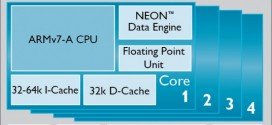ARM chip makers (and I hope AMD, too, but they’ll probably wait another year to adopt this) will finally catch-up to Intel (more or less) in process technology when they move to 14/16nm FinFET, especially since Intel is rumored to maintain Haswell for next year, and delay Broadwell to 2015, which was supposed to be their chip at 14nm. ARM chip makers will also switch to 14/16nm in 2015. They’ll also finally switch to FinFETs so they’ll catch-up in that way, too.
This could also be AMD’s “big moment” where they start to win some mindshare back, especially with the “techies”, who might start switching to AMD if that Mantle API proves to be the real deal, and many game developers adopt it.
But if I were them I’d really try to switch to 16nm FinFET as soon as possible in 2015, in order to catch-up with Intel in performance and power consumption on the notebook/PC side. That’s one of the biggest, if not the biggest reasons why AMD is so much behind Intel.
There are other reasons, too, but that’s probably the biggest. They are like a generation and a half (3 years) behind Intel in process technology, and by default that puts them way behind. So whatever it costs, they need to make it happen early 2015. It will be well worth it in terms of mindshare and sales, if they will be at least “competitive” with Intel on this, and then win the enthusiast crowd from them with stuff like heterogenous computing and the Mantle API.
So please don’t screw this one up, AMD, by waiting a whole year, or even half a year, before 14/16nm FinFET gets cheaper for you. You need to get back in the performance game on the CPU side, and you also need to get back in the power consumption game. Going early with 14/16nm is really the main way to do that.
ARM chip makers should also maintain their competitiveness in performance and power consumption when they switch to FinFET, against Intel. They’ve already managed to do that so far, but mainly because Intel has been to slow with Atom, which still doesn’t have a 22nm “trigate” smartphone version yet, and by the time it has, ARM chip makers will be moving to 20nm in early 2014. Then in 2015 they’ll also move to 14/16nm FinFET, probably even ahead of Intel for smartphones, so they’ll never lose the edge against Intel.
 TechDomino
TechDomino



